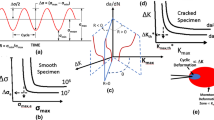Abstract
A new method of plotting limit stress diagrams is set forth. The method is based on the hypothesis of unified limit diagram invariant to the number of cycles to failure. The unified diagram is given by a transcendental power function whose exponent is considered an additional material constant characterizing the sensitivity of the material to cycle asymmetry (stress ratio). The equations derived on the basis of this function encompass all forms of limit stress diagrams, including convex, nearly rectilinear, and concave ones. The method is tested for a wide range of metallic and composite materials subjected to asymmetric tension-compression, bending, and torsion.
Similar content being viewed by others
REFERENCES
L. N. Bol’shev and V. N. Smirnov, Tables of Mathematical Statistics [in Russian], Nauka, Moscow (1968).
A. Z. Vorob’ev, B. I. Ol’kin, V. N. Stebenev, and T. S. Rodchenko, Fatigue Strength of Structural Members [in Russian], Mashinostroenie, Moscow (1990).
H. J. Gough, Fatigue of Metals, London (1924).
V. P. Golub and V. I. Krizhanovskii, “Evaluating the limit state of materials under asymmetric high-cycle loading,” Probl. Prochn., No. 4, 3–15 (1994).
N. I. Gordeev, “Ultimate cyclic strength for asymmetric cycles,” in: Strength of Metals under Variable Loads [in Russian], Izd. AN SSSR, Moscow (1963), pp. 119–126.
D. S. Elenevskii and L. M. Shneerson, “Endurance of surface-impregnated steel parts under asymmetric cyclic loading,” Vestn. Mashinostr., No. 10, 17–22 (1960).
I. A. Oding, Strength of Metals [in Russian], ONTI, Leningrad-Moscow (1935).
P. P. Oldyrev, “Influence of the mean cyclic stress on the high-cycle fatigue of reinforced plastics under axial loading,” Mekh. Komp. Mater., No. 5, 850–859 (1984).
P. P. Oldyrev, “Limit stress diagram for reinforced plastics under high-cycle asymmetric bending,” Mekh. Komp. Mater., No. 1, 70–72 (1985).
S. V. Serensen, V. P. Kogaev, and P. M. Shneiderovich, Load-Bearing Capacity and Strength Design of Machine Parts: A Handbook [in Russian], Mashinostroenie, Moscow (1975).
V. T. Troshchenko, A. Ya. Krasovskii, L. A. Sosnovskii, and V. A. Strizhalo, Resistance of Materials to Deformation and Fracture: A Handbook [in Russian], part 2, Naukova Dumka, Kiev (1994).
P. G. Forrest, Fatigue of Metals, Pergamon Press, London (1962).
A. Hald, Statistical Theory with Engineering Applications, John Wiley&Sons, New York, Chapman&Hall, London (1946).
R. B. Heywood, Designing Against Fatigue, Chapman & Hall, London (1962).
W. T. Chodorowski, “Fatigue strength in shear of alloy steel with particular reference to the effect of mean stress and directional properties,” in: Proc. Int. Conf. on Fatigue of Metals London (1956), pp. 122–131.
W. N. Findley, “Fatigue test of a laminated Mitscherlich-paper plastic,” Proc. ASTM, 45, 878–903 (1945).
V. P. Golub, “The nonlinear mechanics of continual damage and its application to problems of creep and fatigue,” Int. Appl. Mech., 36, No.3, 303–342 (2000).
V. P. Golub, “Experimental analysis of high-temperature creep, fatigue, and damage. 1. Analysis methods,” Int. Appl. Mech., 37, No.4, 425–455 (2001).
V. P. Golub, V. V. Kasperskaya, and A. A. Rusinov, “Time to creep failure of thin-walled cylindrical pipes under torsion,” Int. Appl. Mech., 40, No.6, 686–693 (2004).
H. J. Gough and W. A. Wood, “Deformation and fracture of mild steel under cyclic stresses,” Proc. Inst. Mech. Eng., No. 141, 175–193 (1939).
B. J. Lazan and A. A. Blatherwick, “Strength properties of rolled aluminum alloys under various combinations of alternating and mean axial fatigue stresses,” Proc. ASTM, 53, 856–870 (1953).
D. Revuelta and A. Miravete, “Fatigue damage in composite materials,” Int. Appl. Mech., 38, No.2, 121–134 (2002).
Ya. A. Zhuk and I. K. Senchenkov, “Approximate model of thermomechanically coupled inelastic strain cycling,” Int. App. Mech., 39, No.3, 300–306 (2003).
Author information
Authors and Affiliations
Additional information
Translated from Prikladnaya Mekhanika, Vol. 40, No. 11, pp. 106–116, November 2004.
Rights and permissions
About this article
Cite this article
Golub, V.P., Krizhanovskii, V.I. & Pogrebnyak, A.D. A method for fatigue analysis of metallic and composite materials under asymmetric high-cycle loading. Int Appl Mech 40, 1281–1289 (2004). https://doi.org/10.1007/s10778-005-0035-2
Received:
Issue Date:
DOI: https://doi.org/10.1007/s10778-005-0035-2



